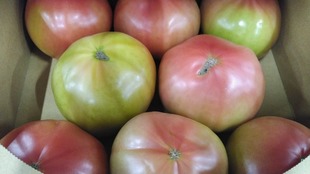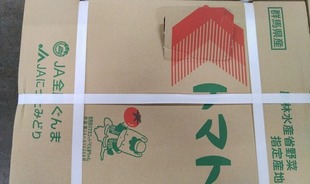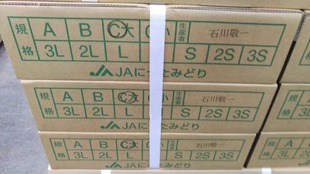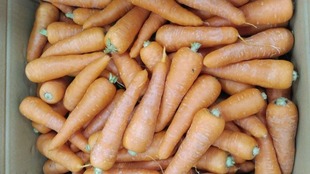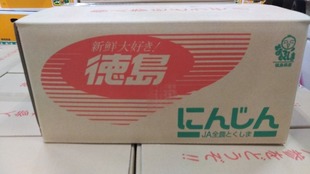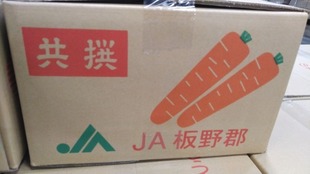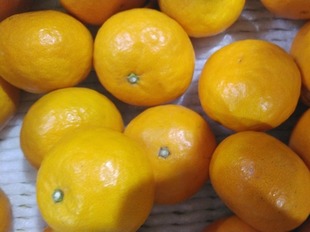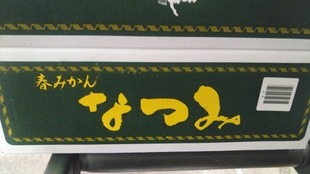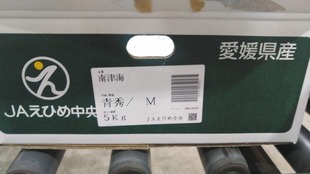【Product name】
Bitter gourd(レイシ)
【Type】
Momordica charantia var. pavel
【Producing area】
Uto City, Kumamoto Prefecture, Uki City, Kumamoto City, Misato Town, Shimomashiki District (JA Kumamoto Uki, JA Kumamoto Keizairen)
【Origin of name】
In Chinese, it was called bitter melon (gugua), and in Okinawa it is officially written as “goya” with a stretch bar at the end, and it is thought that it led to this excellent agricultural product. Bitter melon has various names such as “goya”, “reishi”, and “tsurureishi” depending on the region.
【Major features】
The shipment of “Goku-Wase Mikan”, which is cultivated in Uki City, Kumamoto Prefecture, will start on September 13, 2022, and the departure ceremony for the truck loaded with the first shipment is being held. In Misumi Town, Uki City, where citrus fruits are thriving, 200 farmers seem to grow low-acidity, easy-to-eat Goku-Wase brand mandarin oranges, Hi no Akari. At the departure ceremony held at the JA Kumamoto Uki no citrus sorting site, JA officials and cultivators gathered to take the lead. Full-scale shipment of perennial gypsophila began in early September within the same JA jurisdiction, which is one of Japan’s leading gypsophila production areas. 30 cases were shipped from Kitaei Nou Center (Shimada, Jonan Town, Minami Ward, Kumamoto City). By June 2023, it plans to ship 60,000 cases (approximately 6 million bottles) nationwide and sell 500 million yen. At the time of shipment, officers of the JA Flower Club gather to check the quality of the excellent agricultural products to be shipped. There are 46 Gypsophila producers in the JA jurisdiction, and the planted area is said to be about 14 hectares. The 2022 crop is blessed with stable weather, and the growth is good, and it seems that the ratio of the upper classes is slightly higher. It seems that the department is working together to ensure stable shipments even during periods when shipments are down. For this reason, it is highly evaluated in the market, and about 60% of sales are based on fixed-price long-term contracts. The department, which will celebrate its 20th anniversary next year, seems to continue to sell well, with sales exceeding 500 million yen for the first time in 2021. The 2004 JA Kumamoto Uki Ginger Subcommittee, which dates back to about 18 years ago, originated from the same JA located in the center of Kumamoto Prefecture. It seems to have been made up of However, the members of Ogawa Town and Toyono-mura merged in June 2004, and it seems that the project was implemented only by the members of Ogawa Town(On January 15, 2005, Misumi Town and Shiranui Town, Uto District merged with Matsubase Town and Toyono Town, Shimomashiki District to form Uki City.)as the JA Kumamoto Uki Ogawa Ginger Section. Ginger here seems to have been cultivated along the slopes of the mountains at altitudes ranging from 20 m to 150 m. In 2003, the number of members was 137, and the ginger cultivation area was 54.1 hectares. Adjacent to the Kumamoto Plain to the north and the Yatsushiro Plain to the south, this area is famous for its relatively mild climate and location suitable for growing ginger. According to alic’s Research Information Department Research Information Section 2, the ginger subcommittee aims to establish a production system that focuses on safe and secure ginger production through reduced pesticide and low pesticide cultivation. It seems that yellow anti-moth lights were introduced as part of the structural reform promotion special measures project. One of the problems in cultivating ginger in this area is the larvae of the armyworm (a type of nocturnal moth), which hatches mainly in April and May. , It becomes a pupa in about a month.) There is a countermeasure against feeding damage of Mei moths. If noctiluca lays eggs on ginger leaves and leaves them unattended, the larvae will eat the ginger leaves, and as a result, the growth of ginger will be hindered. As a usual countermeasure, pesticides such as molting inhibitors are sprayed once every 10 days from June, when planting is finished, until the end of September, when harvest time, to exterminate larvae. However, it seems that there are several problems with pesticide spraying. First of all, it seems that pesticide spraying at this time of the year when high temperatures are conspicuous cannot be done during the daytime, and as a result, the work must be done early in the morning and in the evening, resulting in time constraints. It seems that the average cultivation area of full-time farmers in this area takes about three days for one spraying. Even at that time, it seems that the work of spraying pesticides in the summer required a lot of labor for ginger farmers, who were aging rapidly. In addition, it seems that the frequent use of pesticides will hinder the sales strategy in the current situation of agriculture, where safety and security are touted. In recent years, yellow moth-proof lamps, which have been widely used in areas where reduced or low-pesticide cultivation is being promoted, seem to be able to limit the behavior of nocturnal pests such as night moths. For the JA Kumamoto Uki Ginger Subcommittee, which wants to establish a safe and secure ginger production system, the introduction of the yellow anti-moth lamp seems to have been an effort in line with their goals. Since the project site is located in a hilly and mountainous area, the JA ginger section seems to have introduced two types of yellow anti-moth lights for the project, according to the field conditions. One is the sodium lamp type. This type is suitable for relatively wide fields, and it seems that the effective area of one light is about 10 to 20 ares. The other type is a straight tube type fluorescent lamp, and although the effective range of one lamp is about 1 to 2 ares, it is difficult to locate in hilly and mountainous fields where steep slopes inevitably create steps. It seems to have the advantage of being able to be placed together. The yellow anti-moth lamp was introduced in November 2002, so it seems that the first effect appeared in 2003. To reduce the frequency of pesticide spraying, before the introduction of yellow moth-proof lights, it was necessary to spray pesticides once every 10 days, three times a month, for both insecticide and sterilization purposes, but the introduction of yellow moth-proof lights After that, the same work seems to have been reduced to once a month, which is one-third. As for the reduction of working hours, according to research by the same JA Ginger Subcommittee, it took 56 hours per 10 ares a year to spray pesticides before the introduction of yellow moth-proof lights. I heard that in 2003, after the introduction, the number of hours worked decreased to 26 hours a year, and 30 hours a year. In addition, since the average cultivation area of ginger club members is about 70 ares, it seems that one farmer has been able to reduce the labor hours required for pesticide spraying by 210 hours per year. As for the incidental effect, it seems that most of the ginger cultivation fields in the jurisdiction area are along farm roads with little traffic. The yellow moth-proof lights are illuminated from sunset to dawn, so they seem to have a crime-prevention effect in this area. From the verification, it seems that the special measure project for promoting structural reform of vegetables by the project proponent had a certain effect. The reduction in the frequency of pesticide spraying has reduced the burden on ginger farmers, especially the elderly, and the subsequent reduction in working hours seems to have increased the spare capacity of growers. In addition, the reduction in work during the hot summer was more effective than the reduction in the number of actual working hours for farmers, and seemed to have led to an increase in their willingness to produce. The reduction in the use of pesticides has made it possible to appeal the production of “safe and secure” ginger that the JA Ginger Committee aims to produce. It seems that there is today. The easy-to-eat Uki reishi is Momordica, which has a characteristic bitter taste. There must be many fans who are healed by this unique taste and love it. It is also well-known as a vegetable that is rich in nutrients and prevents summer fatigue. Specifically, it is excellent in vitamin C, iron, and dietary fiber, and seems to contain many nutrients that modern people tend to lack. Reishi produced in Uki is a variety called ‘Erabu’, and one of its characteristics is that it has little bitterness. Erabu Bitter gourd contains a lot of vitamin C, which protects the body from UV rays and heat and is good for the skin, according to Yae Agricultural Co., Ltd., headquartered in Kosei Town, Isahaya City, Nagasaki Prefecture. In addition, it is said to be effective in lowering blood pressure, blood sugar levels, and cholesterol levels in the blood. Bitterness also seems to increase appetite. The leaves are medium and dark green. The grass is vigorous and persistent, and it seems to be rich in yield. The color of the pericarp turns glossy and dark green, the vertical warts are cut short, and the surface of the warts is rounded, so it seems that there is little shipping pain. Fruit length is around 30 cm, fruit weight is around 300 g, and it seems to be a voluminous fruit with a slightly fat body. In addition, as a shipping guideline, the fruit length is 28 to 32 cm, the fruit diameter is 3.5 to 4 cm at the shoulder, 5.5 to 6 cm at the body, 4 to 4.5 cm at the buttocks, and the weight is around 300 g. There is little occurrence of bruises, the fruit shape is uniform, and the color of the peel is less disturbed, so it is said to have an excellent product rate. alic Survey Report (Vegetable Information April 2014): As a consistent effort from seed supply to sales, focusing on JA Zen-Noh’s original mini tomato “Angele”: According to Mr. Izawa of the Survey Information Department, mini Introducing the efforts of JA Kumamoto Economic Federation and JA Kumamoto Uki as an initiative to promote Angela production in Kumamoto Prefecture, which boasts the highest shipment volume of tomatoes in Japan at 22,600 tons (Ministry of Agriculture, Forestry and Fisheries “2012 Vegetable Production and Shipment Statistics”). Is doing. Regarding the production promotion of Angele at Keizairen, the Federation of Economics, which was introduced to Angele by JA Zen-Noh, was interested in stable sales. Considering the selection of JA that can experimentally work on the production area (shipment from October to July of the following year). Trial cultivation started in 2011 at 3 JAs in the prefecture with a cultivation area of 92 ares. In the same year, the shipment amount was 63 tons, and it seems that they were able to raise a certain level of test results. After that, we promoted planting in each JA of mini tomato production areas in winter and spring. ANGELLE tomatoes are well-balanced sweet and sour, and are known around the world as snack-type mini tomatoes that have never been seen in Japan. Rich in lycopene, which has an antioxidant effect, it is good for beauty and health, and since it has little jelly, the juice does not easily splatter, and it is easy to eat because it has no calyx, so it is popular as a snack for children. It was bred by Syngenta Japan Co., Ltd. (Harumi, Chuo Ward, Tokyo) and has been on the market in Europe since 2009. In Japan, JA Zen-Noh seems to have conducted aptitude tests, etc., but started trial cultivation and sales in 2011. In the same year, 1.7 ha was planted in 9 JAs nationwide. When it was sold on a trial basis in Tokyo and Osaka, mainly at specific mass retailers, it was well received. It seems that the contract for the exclusive supply of seeds has been reached. The average yield of Angele tomato is 5t per 10 a in summer and autumn, and 9 t per 10 a in winter and spring. JA ZEN-NOH has a policy of carefully increasing the cultivated area by identifying production areas so that it can be shipped systematically throughout the year. And seems to be increasing. Furthermore, grapes in the Uki area are cultivated on 62 ha, and it seems to be the number one production area in the prefecture, accounting for 40% of the cultivated area in the prefecture. Above all, it seems that the main cultivar “Kyoho Grapes” occupies more than 50% of the cultivated area in the jurisdiction. I have heard that local governments are supporting initiatives aimed at maintaining the brand as a grape production area and creating attractive products. On July 21, 2022, the grape “Kyoho” fruit competition is being held at JA Kumamoto Uki main office while thoroughly implementing infection prevention measures (sponsored by JA Kumamoto Uki Grape Section Matsubase Branch). The fair is held every year with the aim of motivating producers to produce more, and this year there were 11 entries, which seems to have been an eye-opener. At the fair, six judges, consisting of JA Kumamoto Uki, city staff, and representatives of the producers, judged the quality of coloring, the size of the bunches and fruits, the uniformity of the grains, and whether they had a high sugar content and good taste seems to have gone In mid-July, when the fair was held, in addition to the heavy rainfall, the minimum temperature was higher than in an average year. However, due to daily efforts such as production management, the quality of the exhibited fruits was all good, and it seems that it was difficult to rank them. Above all, the top fruit had a sugar content of over 18 degrees, and the quality and appearance were excellent. The Agricultural Extension and Promotion Division will continue to support the production of high-quality grapes of Kyoho grapes, the main grape variety. In addition, using the “Shine Muscat Grapes” cultivation manual that was created last year, we are working to disseminate cultivation techniques for producing high-quality fruits seems to be. And support farming establishment. May 8th is “Goya Day”. Bitter melon, which is a typical agricultural product, is a bitter melon vegetable, but it contains a lot of nutrients such as vitamin C, and it seems that it is often eaten in order to spend the hot summer of Okinawa well. On Miyakojima, bitter melon is called “Gora”. In Okinawa, it is called “Goya”, and in the United States, it is called “Bitter Melon”. Among the many dishes, goya champuru is popular. Tempura is also delicious, but if you eat it raw as a salad, it will be a bit bitter, but if you add dried bonito flakes, it will be very delicious. It is said that the bitter melon was transmitted from China during the Edo period. In Okinawa, the name “Bitter sweet” was written in a book called “Ryukyu Kingdom Origin” (Kangxi 52: 1713: Shotoku 3) during the Ryukyu Kingdom era. Famous as a healthy vegetable in Okinawa. Eat unripe fruits before ripening. Bitterness is attractive, but if you are not good at it, you can get rid of it by sprinkling salt on it and boiling it over it. It’s said to be useful for energy saving while enjoying gardening. The name is green garden of bitter melon. Hard skin bitter melon prevents the loss of its components and can absorb nutrients efficiently even when cooked. Rich in vitamin C. In addition, the nutritional value is characteristic, and the saying “Good medicine tastes bitter / Good medicine is bitter in to the mouth” is originally associated with “bitter melon”. Goya, which has been eaten by Okinawans since the Ryukyu dynasty, was previously cultivated in the gardens of homes. Occasionally, the elderly in the neighborhood will have a hard time competing for the result. Recently, it has been cultivated year-round and can be eaten regardless of the season, but the season is from April to July, which is a representative vegetable of summer. In 2022, due to the good weather in March, there were more flowers than usual, and it was difficult to thin the fruit, but I heard that the high-quality fruits with straight and neat warts were produced and shipped smoothly. I would like to hope that it will lead to profit for producers even a little while materials etc. are soaring.

Reishi is said to have originated in tropical Asia. It is unknown when it was born, but it is believed that it was introduced to China around the 15th and 16th centuries, and that it was brought to Japan from China around the 16th century during the Edo period. In Okinawa, there is a book written during the Ryukyu Kingdom period called the Ryukyu Kingdom Yuraiki (the oldest systematic topographical material on the Ryukyu Kingdom). A topography of the Ryukyus compiled by the Chuzan royal government in 1713. Based on these materials, the Kyuukyura Yose magistrate and nakadori (assistant to the magistrate) edited the map of Ryukyu. A total of 21 volumes. Orders to collect materials related to history, rituals, etc. will be issued to various parts of the Ryukyu Islands.”, and since the name of bitter melon is written in it, it seems that it already existed in the Ryukyu Kingdom at that time. Once upon a time. It used to be eaten in Okinawa Prefecture and southern areas of Kyushu, but in 1993, fruits and vegetables from Okinawa Prefecture began to be shipped outside the prefecture, and with the Okinawa cuisine boom, it has spread nationwide.

Cultivated varieties include 40 to 60 cm long cylindrical ‘青長’ and ‘白長’ types, and 10 to 20 cm and medium thick ‘Aonakacho’ types. In recent years, the ‘青中長’ type, which has a dark green color and less bitterness, is favored by the market, and cultivation is apparently increasing. It is mainly produced in warm regions such as Okinawa, Kagoshima, and Miyazaki, but it seems to be expanding to the east as consumption increases. Cultivation is generally done outdoors, and in warm areas it is sown from March to April and harvested from July to October. There are many shelf tailoring and three-dimensional tailoring, but it seems that there is also ground crawling cultivation. It is produced year-round by forcing cultivation and precocious cultivation using facilities. In June 2022, JA Kumamoto Uki Ogawa District Women’s Division uses a green curtain made of bitter gourd (bitter gourd), and it seems that it leads to energy saving that is conscious of the global environment. The department’s activities seem to be related to Sustainable SDGs Goal 13, “Take concrete action against climate change.” In April, bitter gourd seedlings were distributed to 34 applicants in order to reduce the summer heat and save electricity with green curtains made from vines and leaves. Bitter gourd seems to be growing well under the eaves of the member’s house.

Goya in Japan can be divided into spindle-shaped (green), cylindrical (green), triangular (green), and egg-shaped (white) according to the planting shape and color. In the past, it was cultivated as a local vegetable on a limited basis in Okinawa Prefecture and the Kyushu region. It seems to have spread to the Kanto region as well. Each prefecture is also focusing on breeding and dissemination of varieties, such as Hoshibushi bitter gourd, which has a high female flower rate, Natsu Natsumori Sakari, a greenhouse variety, and Shiokaze bitter gourd, which is suitable for greenhouse cultivation in winter. Also, I heard that Ka-ko No. 5 bitter gourd is a cultivar that was bred at an experimental site in Kagoshima prefecture.
